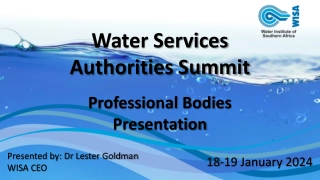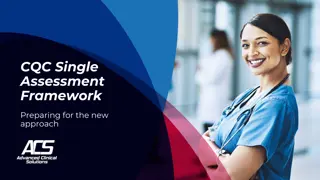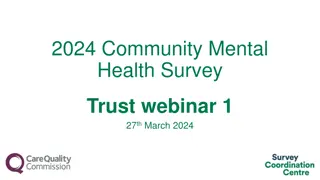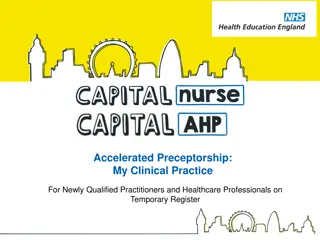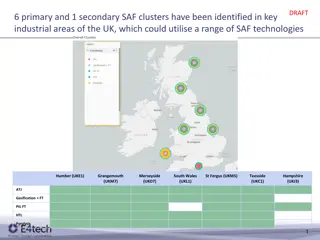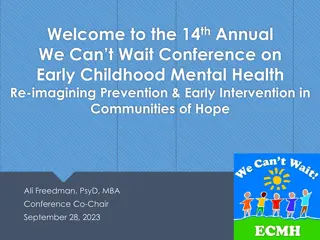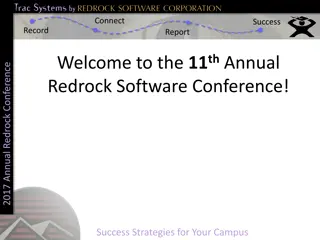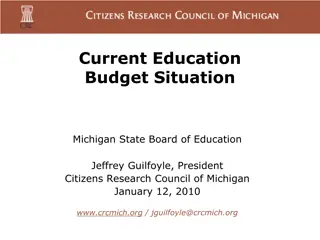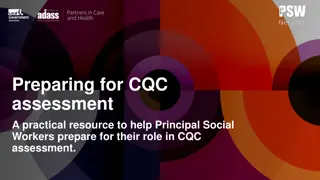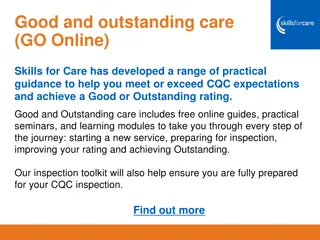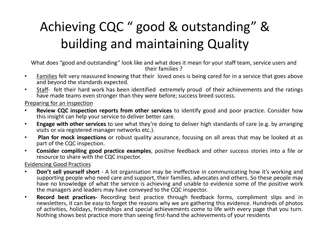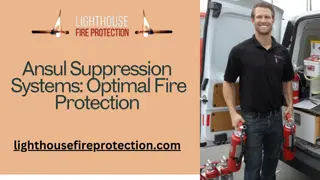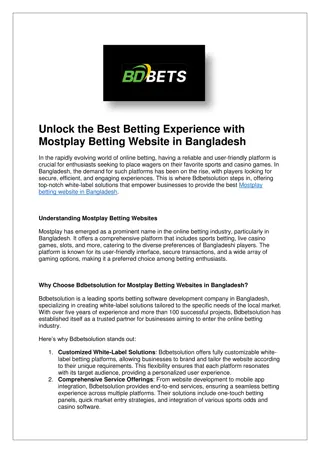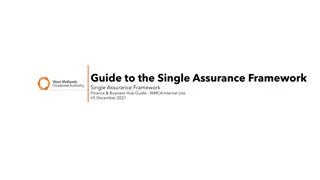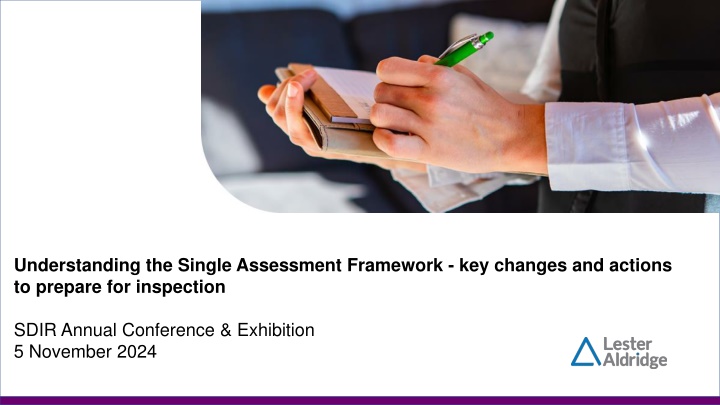
Key Changes in Single Assessment Framework for Inspection Preparation
Explore the changes in the Single Assessment Framework for the upcoming inspection preparation. Discover the shift from multiple assessment frameworks to a single one, with ongoing monitoring and updated terminology. Stay informed to adapt effectively.
Download Presentation

Please find below an Image/Link to download the presentation.
The content on the website is provided AS IS for your information and personal use only. It may not be sold, licensed, or shared on other websites without obtaining consent from the author. If you encounter any issues during the download, it is possible that the publisher has removed the file from their server.
You are allowed to download the files provided on this website for personal or commercial use, subject to the condition that they are used lawfully. All files are the property of their respective owners.
The content on the website is provided AS IS for your information and personal use only. It may not be sold, licensed, or shared on other websites without obtaining consent from the author.
E N D
Presentation Transcript
Understanding the Single Assessment Framework - key changes and actions to prepare for inspection SDIR Annual Conference & Exhibition 5 November 2024
Please note The content of these slides was accurate at the time of creation on 24 October 2024. Changes to the approach are still being made by CQC and updates continue to be received. We advise that you stay abreast of these at www.cqc.org.uk/assessment
From 27 February 2024,SAF was rolled out to all CQC-regulated providers. All assessments & inspections, CQC notifications & applications to register a new activity or service were to be assessed using the new approach and new online notifications.
FORMER overview of the SAF Existing NEW - 34 quality statements NEW- 6 evidence categories NEW Existing
Overview of the Key Changes Multiple assessment frameworks Single assessment frameworks Ongoing monitoring with inspections scheduled according to previous ratings An ongoing assessment of quality and risk with ratings changing more frequently Evidence gathered during onsite inspections (single point in time) Evidence gathered at multiple points in time and not just through inspection, also through assessments Judgements and ratings decisions made using ratings characteristics Teams assigning scores to evidence Ratings update with a short narrative a score and a percentage Narrative inspection report Ratings characteristics New scoring system Ratings by key question with a single word outcome Scores, ratings and in future benchmarking
Understanding new terminology What are Key questions? The headings under which the quality statements are grouped. What are We Statements / Quality Statements ? Quality statements are the commitments that providers, commissioners and system leaders should live up to. Expressed as we statements , they show what is needed to deliver high-quality, person-centred care. What are I Statements ? They reflect what people have said matters to them They have a key role in the People s experience evidence category to help us gather, listen to and act on people's experiences. Their experience of care will inform our decision-making and lead us to take appropriate action. This applies to all our work. We will develop tools and techniques that use the I statements to help us gather evidence for our assessments. For example, in focus groups, interviews and case tracking.
Understanding new terminology What are Evidence Categories ? Areas CQC will focus on when assessing a particular quality statement. They are grouped into six categories: People's experience of health and care services, Feedback from staff and leaders, Feedback from partners, Observation, Processes, Outcomes (not adult social care) Where is the Best Practice guidance? Learning culture - Care Quality Commission (cqc.org.uk) Where is the evidence category Sector Specific guidance? Assessment - Care Quality Commission (cqc.org.uk)
THAT, HOWEVER, WAS THEN Then being Wednesday 16 October 2024)
15 October Press Release Align the organisation around sector expertise by appointing at least 3 chief inspectors to lead on regulation and improvement of hospitals, primary care, and adult social care services. Consideration will also be given to whether a fourth chief inspector is needed to lead on regulation and improvement of mental health services. CQC will support staff to strengthen their own sector knowledge and expertise and will work with its new Chief Executive, Sir Julian Hartley, key stakeholders, and colleagues to review whether any further changes are needed. Modify the current assessment framework to make it simpler and ensure it is relevant to each sector. This will enable CQC to carry out and report on inspections more quickly. It will retain the 5 key questions (safe, effective, caring, responsive and well-led) across all sectors, but will amend the 34 quality statements to ensure clarity and remove duplication. CQC will stop scoring individual evidence categories. Ensure they have the right systems and tools in place to support its regulatory activity. CQC is working to stabilise and fix its regulatory platform and provider portal in the immediate term. While it does this, CQC is exploring options for delivering assessment activity away from the current systems, so that it can rapidly assess, rate, and publish reports for the public. They will ensure these assessments are securely recorded. Improve the experience for providers registering with CQC. They are urgently reviewing what specific changes are needed to the provider portal to do this.
14 October: Update to CQC Website (not official announced) In exceptional circumstances, you can submit factual accuracy comments using our MS Word form instead, for example if you are unable to use our online process. Factual accuracy form for assessments under the new single assessment framework
We have therefore been informed that the system is changing, but not when or how.
Quality Statements & Priorities CARING Kindness, compassion and dignity Treating people as individuals Independence, choice and control Responding to people's immediate needs Workforce wellbeing and enablement EFFECTIVE Assessing needs Delivering evidence-based care and treatment How staff, teams and services work together Supporting people to live healthier lives Monitoring and improving outcomes Consent to care and treatment SAFE Learning culture Safe systems, pathways and transitions Safeguarding Involving people to manage risks Safe environments Safe and effective staffing Infection prevention and control Medicines optimisation Total possible score 24 Total possible score 20 Total possible score 32 RESPONSIVE Person-centred care Care provision, integration, and continuity Providing information Listening to and involving people Equity in access Equity in experiences and outcomes Planning for the future WELL LED Shared direction and culture Capable, compassionate and inclusive leaders Freedom to speak up Workforce equality, diversity and inclusion Governance, management and sustainability Partnerships and communities Learning, improvement and innovation Environmental sustainability sustainable development Total possible score 28 Total possible score 28
Additional assessment areas CARING: Workforce wellbeing and enablement We care about and promote the wellbeing of our staff, and we support and enable them to always deliver person-centred care Feedback from staff and leaders Processes: Mechanisms to monitor, improve and promote staff safety and wellbeing Staff management policies Staff sickness, vacancy and turnover rates WELL-LED: Freedom to Speak Up We create a positive culture where people feel that they can speak up and that their voice will be heard Feedback from staff and leaders Processes: Mechanisms for seeking and responding to staff feedback Whistleblowing records
Additional assessment areas WELL-LED: Shared Direction and Culture We have a shared vision, strategy and culture that is based on transparency, equity, equality and human rights, diversity and inclusion, engagement and understanding and meeting the needs of people and our communities. Feedback from staff and leaders Processes: Business plans Equality, diversity and inclusion policy Monitoring service objectives Vision, aims and strategy WELL-LED: Workforce equality, diversity and inclusion
Additional assessment areas WELL-LED: Environmental sustainability sustainable development commencing later in 2024 We understand any negative impact of our activities on the environment and we strive to make a positive contribution in reducing it and support people to do the same Feedback from staff and leaders Processes: Green and carbon reduction plans and policies Processes for recycling Staff training in environmental sustainability
Role of Assessors and Inspectors Inspectors Sector specialist accountable for carrying out site visits for the purposes of gathering evidence (inspections) Lead enforcement activity Work with assessor to support decision making on judgments of quality Develop relationship with provider to support on-site activity Assessors Sector specialist accountable for ongoing view of quality, safety and risk. Make judgements as part of assessments, working with inspector and the rest of the team to bring together evidence Decides on and authorises regulatory activity Supports off-site evidence collection One Assessor will work with many inspectors
First Scores - example When we start to assess services using this new approach, we will need to apply scores for each quality statement. Score 4 3 2 1
First Scores - Based on example: SAFE Learning culture Safe systems, pathways and transitions 2 Safeguarding Involving people to manage risks Safe environments Safe and effective staffing Infection prevention and control Medicines optimisation EFFECTIVE Assessing needs Delivering evidence-based care and treatment 3 How staff, teams and services work together Supporting people to live healthier lives Monitoring and improving outcomes Consent to care and treatment CARING Kindness, compassion and dignity Treating people as individuals Independence, choice and control Responding to people's immediate needs 3 Workforce wellbeing and enablement 2 3 3 3 3 2 2 2 2 2 2 3 3 3 3 2 14/ 20 SCORE SCORE:16/32 SCORE:18/24 PERCENTAGE70% PERCENTAGE:50% PERCENTAGE:75% Based on Well-led Based on Well-led WELLLED Shared direction and culture Capable, compassionate and inclusive leaders Freedom to speak up Workforce equality, diversity and inclusion Governance, management and sustainability Partnerships and communities Learning, improvement and innovation Environmental sustainability sustainable development RESPONSIVE Person-centred care Care provision, integration, and continuity Providing information Listening to and involving people Equity in access Equity in experiences and outcomes Planning for the future 2 2 2 2 2 2 2 3 2 3 3 3 3 3 No score as new area Based on Effective SCORE:14/28 SCORE:20/28 PERCENTAGE:50% PERCENTAGE:71%
Starting point: RI or Inadequate overall Every service is different, of course, and so the amount of work required to confirm or change a rating will vary depending on the starting position. When carrying out an assessment of a service that is either inadequate or requires improvement all quality statements under the key question that are rated inadequate or requires improvement will be reviewed. It has always been true that a provider with many key questions rated as requires improvement will require significantly more work to re-rate as good than one key question rated as requires improvement. That does not change in the new approach, though the amount of work per key question rating is reduced. Our new approach gives us the opportunity to do that work in smaller packages of work over shorter time frames, working on and off site, which providers will find less disruptive. 26 March 2024, Ian Trenholm, CQC s Chief Our intention is to review all of the quality statements in a key question where it was previously rated as inadequate or requires improvement. 30 April 2024, CQC update for adult social care providers James Bullion, Chief Inspector of Adult Social Care and Integrated Care Executive s blog
Limiters? Yes and No! By using the following rules, we can make sure any areas of poor quality are not hidden. If the key question score is within the: good range, but there is a score of 1 for one or more quality statement scores, the rating is limited to requires improvement outstanding range, but there is a score of 1 or 2 for one or more quality statement scores, the rating is limited to good. We do not have rules or limiters for different combinations of evidence category scores. But we can apply our professional judgement if the quality statement score produced does not reflect quality for that topic... This will particularly be where we need to aggregate ratings that range from inadequate to outstanding.
Rating Limiters: Caring key question Quality statement Score Kindness, compassion and dignity 3 Thresholds 25-38% Inadequate, 39-62% requires improvement 63-87% good Over 87% outstanding Treating people as individuals 3 Independence, choice and control 3 Responding to people s immediate needs 3 Workforce wellbeing and enablement 1 In this example the provider scoring 65% would be REQUIRES IMPROVEMENT for CARING despite the score sitting well within the GOOD range Total score for Caring key question Maximum possible score for the safe key question (5x4) 13 20 Percentage score for Caring (X/20 *100) 65 % OVERALL RATING - If we identify concerns in an assessment, we will use our professional judgement to decide whether to depart from applying our ratings principles. This will particularly be where we need to aggregate ratings that range from inadequate to outstanding.
CQC focus areas The probability of increasing rating is dependent on number of quality statements assessed Thresholds are applied to convert the percentage to a rating: 25 to 38% = inadequate 39 to 62% = requires improvement 63 to 87% = good over 87% = outstanding SAFE Learning culture Safe systems, pathways and transitions Safeguarding Involving people to manage risks Safe environments Safe and effective staffing Infection prevention and control Medicines optimisation Total score Maximum possible score 2 2 3 3 2 3 2 2 19 32 Aggregated ratings: if any Inadequate or more than one Requires improvement will not usually be Good BUT professional judgement! 19 / 32 = 59% Need 21/32=65% to flip to Good
Promote Your Service!!! Were there elements of our practice that was outstanding? Unfortunately we cannot comment on this at this time.I would recommend in future sharing any elements of practice with us that you consider "Outstanding" or "innovative", so that we can consider whether to conduct an assessment to review these.
What is next? CQC Update 16 October 2024:- Share your views Following the publication of reports from Dr Penny Dash and Professor Sir Mike Richards, both of which discuss the design and implementation of the single assessment framework, we would like to highlight an opportunity for adult social care providers to contribute to future work in this area. The Care Provider Alliance (CPA), chaired by Professor Vic Rayner OBE, is working with Professor Sir Mike Richards on the review of the single assessment framework and its implementation. The CPA is a coalition of the 10 main national associations that represent independent adult social care providers in England. It advocates for the sector and ensures a co-ordinated response to the major issues that affect it. Members take it in turns to lead the CPA and there is a new Chair each year. Members of the CPA will focus on giving an operational perspective on the single assessment framework from an external care provider s viewpoint. The review will explore aspects such as how the new approach works in practice, its effectiveness, and how providers are experiencing the process. It will also give a view on changes providers would like to see. The first stage of the review will focus on providers experiences of the single assessment framework, either in preparing for it or during inspection. Any managers, deputy managers, senior managers, nominated individuals, quality or compliance leads working in a regulated care service is able to respond to the online survey. Feedback from this survey will inform a second stage, which will look more closely at what people want from CQC for the future. The survey will close at 5pm on Sunday 20 October.
Thank you. We would be happy to answer any questions. Visit: www.lesteraldridge.com for more information Nicole Ridgwell Nicole.ridgwell@LA-law.com or call 07833 232369 The webinars delivered by Lester Aldridge LLP are provided for information purposes only and they are general in nature. They do not constitute legal or other professional advice and should not be relied upon as such. No responsibility for the accuracy and/or correctness of the information, or for any consequences of relying on it, is assumed or accepted by any member Lester Aldridge LLP or as Lester Aldridge as a whole. The content does not negate the requirement for comprehensive assessment of each specific circumstances. If you have any questions relating to this disclaimer or if you require legal advice, please contact info@LA-law.com.

